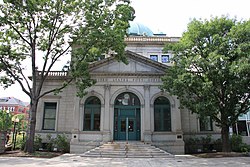Allegheny, PA
| Allegheny City | |
|---|---|
| Former city | |

The Allegheny Post Office is one of the few remaining structures of Allegheny City's downtown
|
|
| Coordinates: 40°26′30″N 80°00′00″W / 40.44167°N 80.00000°WCoordinates: 40°26′30″N 80°00′00″W / 40.44167°N 80.00000°W | |
| Country | United States |
| State | Pennsylvania |
| County | Allegheny |
| Founded | 1788 |
| Incorporated (borough) | 1828 |
| Incorporated (city) | 1840 |
| Annexed (Pittsburgh) | 1907 |
| Elevation | 1,370 ft (420 m) |
| Population (1900) | 129,896 |
| Time zone | EST (UTC-5) |
| • Summer (DST) | EDT (UTC-4) |
| ZIP Code | 15212, 15214, 15233 |
| Area code(s) | 412 |
Allegheny City (1788–1907) is the name of a former Pennsylvania municipality now reorganized and merged into the modern City of Pittsburgh, Pennsylvania. Allegheny City was a right bank municipality located west across the Allegheny River from downtown Pittsburgh, with its southwest border formed by the Ohio River and is known today as the North Side of Pittsburgh. It was annexed by Pittsburgh in 1907. Its waterfront district, along the Allegheny and Ohio rivers, is known as Pittsburgh's North Shore — it is along the north side of the confluence of the Allegheny River with the Monongahela, where they form the Ohio River — the locale achieved fame as the riverside site of Three Rivers Stadium.
The area of Allegheny City included the present Pittsburgh neighborhoods of Allegheny Center, Allegheny West, Brighton Heights, California-Kirkbride, Central Northside, Chateau, East Allegheny, Fineview, Manchester, Marshall-Shadeland, North Shore, Northview Heights, Perry North, Perry South, Spring Garden, Spring Hill–City View, Summer Hill, and Troy Hill.
...
Wikipedia


